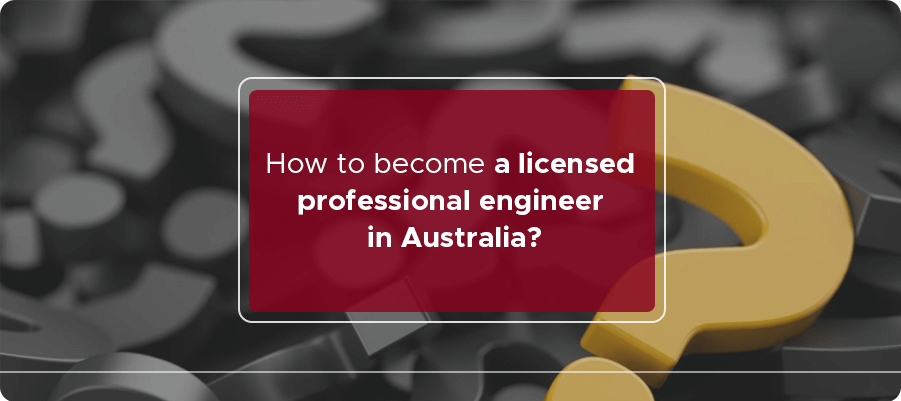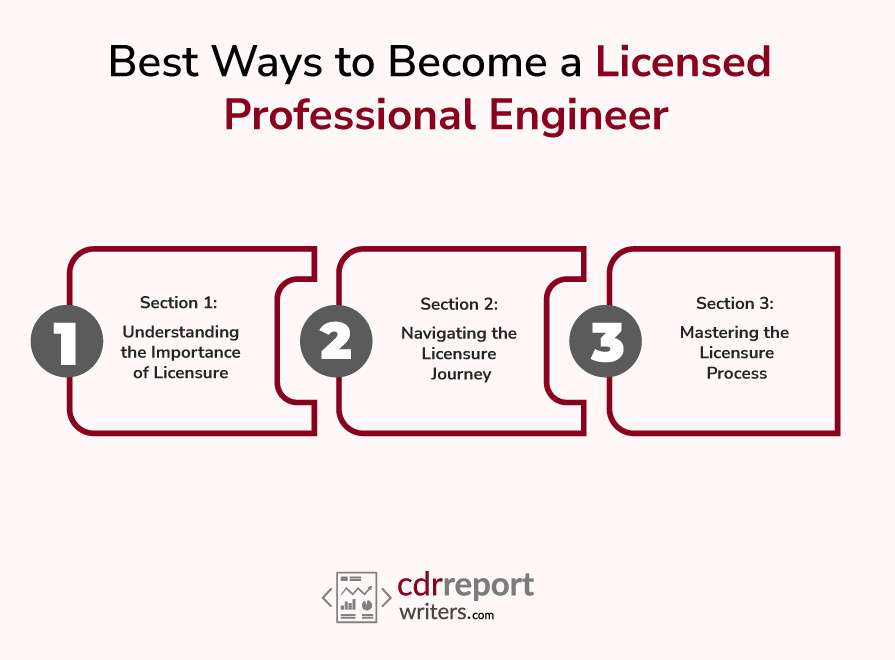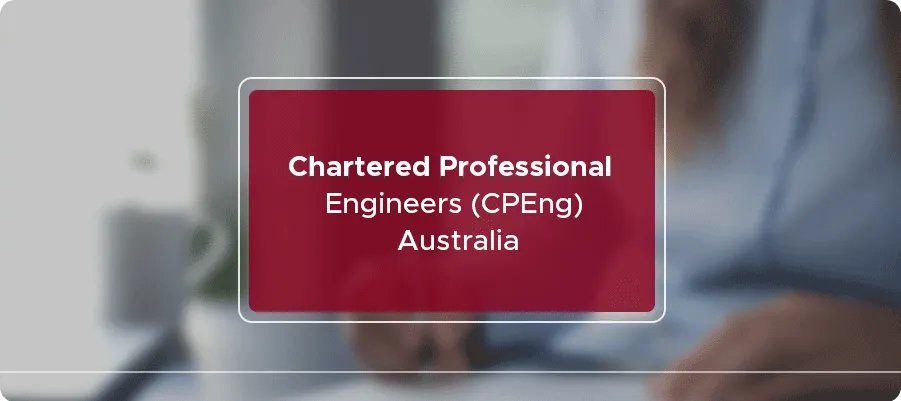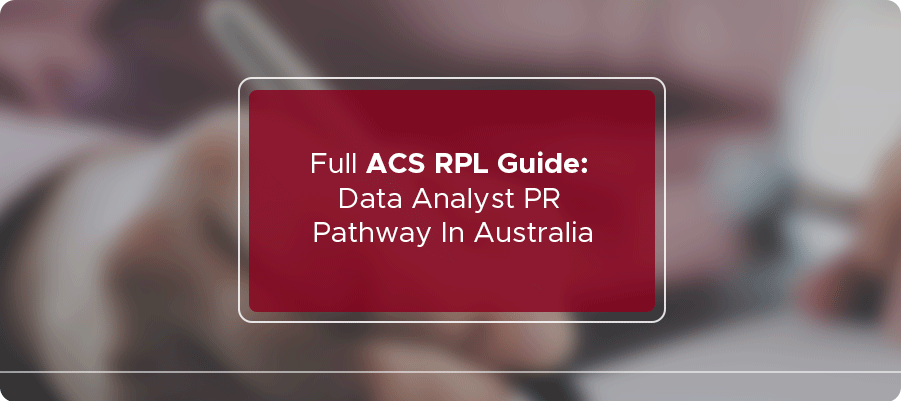
Become a licensed professional engineer in Australia
Becoming a licensed professional engineer in Australia is a significant achievement that requires dedication, education, and completion of the PE exam. This comprehensive guide will provide a stepwise overview of the process, from the educational requirements to obtaining your PE license.
Throughout this blog, we’ll navigate the complex terrain of licensure requirements, from academic prerequisites to practical experience and examinations. Also, we will get into the intricacies of the licensure process, shedding light on state-specific regulations and ensuring you’re well-prepared for every step of the journey.
But this is more than just a collection of facts and figures. We understand that becoming a licensed professional engineer is not just about ticking boxes—it’s about honing your skills, expanding your knowledge, and embracing a mindset of continuous growth. That’s why we’ve curated a wealth of insider tips, expert advice, and real-world experiences to empower you on your path.
Requirements for Professional Engineering
Below are the requirements for Licensed Professional Engineering:
1. Educational Requirements
It is essential to meet specific educational requirements to prepare for the PE exam. Typically, this involves obtaining a bachelor’s degree in engineering from an accredited institution.
The particular engineering discipline or specialization may vary based on your interest. Research the educational criteria set by the licensing board in your jurisdiction to ensure you meet the necessary qualifications.
The bachelor’s degree in engineering provides a comprehensive foundation in mathematics, physics, and engineering principles. The curriculum encompasses various courses such as mechanics, thermodynamics, materials science, and engineering design. Practical laboratory work and engineering projects also get included to develop hands-on skills.
In addition to the bachelor’s degree, some licensing boards may require candidates to complete a Master’s or Doctorate in engineering or a related field. These advanced degrees provide specialized knowledge and expertise, particularly for those aiming for highly technical or research-oriented roles.
When choosing an engineering program, it is crucial to ensure that Australia’s relevant professional engineering body accredits it. Accreditation ensures that the program meets general educational standards and provides the knowledge and skills required for professional engineering practice.
2. Professional Engineer Exam (PE Exam)
The Professional Engineer (PE) exam is a significant milestone in becoming a licensed professional engineer. The PE exam assesses your understanding of engineering principles, problem-solving abilities, and ability to apply knowledge to real-world scenarios. The exam evaluates your competence in your chosen engineering 3 discipline and ensures that you meet the standards set by the licensing board.
The PE exam, administered by Engineers Australia, is divided into two main components: the Principles and Practice of Engineering (PE) exam and the Fundamentals of Engineering (FE) exam. The FE exam is the initial step and is usually taken toward the end of your undergraduate studies or shortly after graduation from a tertiary institution. It assesses your understanding of fundamental engineering principles and is a prerequisite for the PE exam.
Once you have successfully passed the FE exam, you can progress to the PE exam, which is more specialized and tailored to your chosen engineering discipline. This exam delves deeper into the application of engineering principles and evaluates your ability to solve complex engineering problems. It generally includes multiple-choice questions, essay questions, and scenario-based concerns.
The PE exam is an essential requirement for engineer registration and gets recognized by Engineers Australia and other engineering regulatory bodies. Completing the PE exam demonstrates your competence and readiness to practice as a professional engineer.
It is important to note that the PE exam aligns with the Washington Accord. This international agreement sets the standard for engineering education and ensures the mutual recognition of engineering qualifications among participating countries. It means that the knowledge and skills tested in the PE exam adhere to global engineering standards, enhancing the portability and recognition of your engineering credentials beyond Australia.
Preparing for the PE exam requires a comprehensive review of your chosen discipline’s relevant engineering principles and concepts. Utilizing study materials provided by Engineers Australia and other reputable sources, such as review books, practice exams, and online resources, is recommended. Additionally, joining study groups or attending review courses can provide valuable support and direction throughout your exam preparation.
Successfully passing the PE exam is a significant milestone in your professional engineering career. It demonstrates your expertise, competence, and commitment to upholding engineering standards. Upon completing the PE exam and meeting the necessary experience requirements, you can apply for engineer registration with Engineers Australia, solidifying your status as a licensed and registered professional engineer.
Becoming a licensed professional engineer requires dedication, perseverance, and continuous learning. Obtaining an undergraduate degree from a recognized tertiary institution, completing the FE and PE exams, and gaining relevant work experience are crucial steps in achieving professional recognition and contributing to engineering.
Developing a study plan and allocating sufficient time for review to prepare for the PE exam is crucial. Familiarize yourself with the exam pattern, content, and guidelines the licensing board provides. Reviewing reference materials, practicing sample questions, and enrolling in review courses or study groups can also enhance your preparedness for the exam.
Learn More: Design an Ideal CV for Australian Skilled Migration ✈️✈️
3. PE License Application
After completing the educational requirements and passing the PE exam, you can apply for your professional engineer license. The application process involves submitting an application to the relevant licensing board in your jurisdiction. The requirements may vary based on the licensing board and the state or territory where you intend to practice as a professional engineer.
When applying for your PE license, you must typically provide documentation of your education, including official transcripts from your engineering degree program. These transcripts should demonstrate that you have completed the required coursework and obtained the necessary qualifications.
In addition to educational documentation, you must submit evidence of your successful completion of the PE exam. These documents may include official exam results or passing certification from the licensing board or testing organization.
Work experience is another crucial component of the PE license application. Most licensing boards require a certain number of years of professional engineering experience, typically obtained under the guidance of a licensed professional engineer. This experience allows you to gain practical skills, apply theoretical knowledge, and demonstrate competence in real-world engineering projects. Keep detailed records of your work experience, including project details, responsibilities, and the duration of your involvement.
During the application process, you may need to provide references from licensed professional engineers who can attest to your character, competency, and professional conduct. Ideally, These references should come from individuals who have directly supervised your work or had a professional relationship with you in an engineering capacity.
It is crucial to ensure that your application is complete, accurate, and meets all the requirements set by the licensing board. Carefully review the application guidelines provided by the licensing board and seek assistance or clarification if needed. All information must be present to avoid delays in processing your application.
4. Professional Engineering Licenses and Continuing Professional Development (CPD)
Upon approval of your application, you will receive your professional engineer license. This license grants you the legal authority to practice engineering in your jurisdiction and demonstrates your professional competence and commitment to ethical engineering practice.
Maintaining your professional engineering license requires an ongoing commitment to Continuing Professional Development (CPD). CPD involves engaging in activities that enhance your knowledge, skills, and professionalism throughout your career. These activities include attending workshops, conferences, seminars, and technical training programs and actively participating in professional engineering organizations.
Many licensing boards have specific CPD requirements, such as a minimum number of hours or particular areas of professional development. It is crucial to enlighten yourself with the CPD guidelines set by your licensing board and ensure you fulfill the requirements within the specified timeframe.
CPD activities provide opportunities to stay updated with advancements in your field, network with industry professionals, and expand your knowledge and expertise. Engaging in CPD demonstrates your commitment to professional growth, enhances your career prospects, and opens doors to new opportunities within the engineering industry.
Learn More: Australian Visa Options for Qualified Electrical Engineers 🧑🏽✈️🏆
Best Ways to Become a Licensed Professional Engineer
The ideal pathway to becoming a licensed professional engineer is provided below:

Section 1: Understanding the Importance of Licensure
1.1 Why Become a Licensed Professional Engineer?
- Explore the significance of licensure in the engineering field.
- Discover how licensure opens doors to exciting career prospects, prestigious projects, and increased earning potential.
- Gain insight into the legal and ethical responsibilities of a licensed professional engineer.
1.2 Differentiating Licenses: PE, FE, and SE
- Unravel the distinctions between Professional Engineer (PE), Fundamentals of Engineering (FE), and Structural Engineer (SE) licenses.
- Understand the specific requirements and benefits associated with each type of license.
- Determine which license aligns best with your career aspirations and professional goals.
Section 2: Navigating the Licensure Journey
2.1 Educational Requirements
- Gain an overview of the educational prerequisites for licensure, including accredited engineering programs and degrees.
- Learn about alternative paths to licensure for individuals with non-engineering degrees.
- Discover resources and strategies for selecting the proper engineering discipline to match your interests and strengths.
2.2 Gaining Professional Experience
- Explore the importance of obtaining practical experience through internships, co-op programs, and entry-level engineering positions.
- Learn how to document and record your professional experience effectively.
- Find tips for maximizing learning opportunities and accelerating career growth during this phase.
2.3 Preparing for Licensure Exams
- Understand the examination requirements, including the Fundamentals of Engineering (FE) and Professional Engineering (PE) exams.
- Discover effective study techniques and resources to help you prepare for these rigorous exams.
- Learn from the experiences of successful examinees and gain insights into exam strategies and time management.
Section 3: Mastering the Licensure Process
3.1 State-Specific Licensure Regulations
- Navigate the intricacies of state-specific licensure boards and regulations.
- Understand the application process, required documents, and fees associated with licensure in your state.
- Stay updated on any recent changes or updates in licensure requirements.
3.2 Ethics and Professional Responsibility
- Explore the ethical considerations and professional responsibilities of being a licensed professional engineer.
- Learn about codes of conduct, professional standards, and guidelines to uphold integrity in your engineering practice.
- Understand the implications of unethical behavior and its potential consequences on your licensure.
3.3 Continuing Professional Development
- Embrace a mindset of lifelong learning and continuous professional development.
- Discover various avenues for expanding your knowledge, such as attending conferences, pursuing advanced degrees, and participating in professional organizations.
- Learn how to leverage networking opportunities and seek mentorship to enhance your career prospects.
Learn More: Important documents required for CDR in 2023 ⏱⌛️
Pathways for Becoming a Professional Engineer
Becoming a licensed Professional Engineer (PE) is a significant accomplishment that requires a combination of education, experience, and examination.
This comprehensive blog will provide a detailed overview of becoming a PE, including obtaining an engineering degree, gaining work experience, passing the required exams, and applying for a license with the state’s licensing board.
Following these steps, aspiring engineers can embark on a rewarding journey toward professional engineering licensure.

1. Obtain an Engineering Degree
The first step in becoming a PE is to obtain an engineering degree from an ABET-accredited university. The engineering degree provides a solid foundation in mathematics, science, and engineering principles, equipping students with the required knowledge and skills to excel in the field.
ABET accreditation ensures that the program meets specific educational standards and prepares students for a career in engineering. During your studies, it is crucial to recognize that engineering involves various disciplines and specializations.
Focusing on courses aligning with your desired engineering discipline is essential for pursuing licensure. Whether you aspire to become a civil, mechanical, electrical, chemical, or aerospace engineer, selecting suitable courses is paramount.
Consulting with academic advisors and professionals in your chosen field is highly recommended. These experts have in-depth knowledge of the requirements for licensure and can help ensure that you select the appropriate courses to meet those requirements.
They can provide valuable guidance on the procedures that best prepare you for your desired engineering discipline. In the United Kingdom, the Engineering Council is responsible for setting and maintaining standards in the engineering profession. They oversee engineers’ registration and professional development, including the recognition of Chartered Professional Engineer (CPEng) status.
The Engineering Council collaborates with professional engineering institutions to ensure that engineers maintain the necessary skills, knowledge, and competence to practice their respective disciplines effectively.
When choosing your courses, it is essential to consider the requirements set forth by the Engineering Council and professional engineering institutions. These requirements may include specific courses or modules relevant to your chosen discipline.
By aligning your course selection with these requirements, you will be on the correct path toward pursuing licensure as a professional engineer. In addition to consulting with academic advisors, conducting keyword searches related to your desired engineering discipline can provide valuable insights.
Online resources, such as professional engineering institution websites, can provide information on the specific courses, certifications, and qualifications required for licensure. Taking a proactive approach to your course selection and staying informed about the requirements for licensure will enhance your chances of success in becoming a licensed professional engineer.
By choosing the appropriate courses, receiving guidance from experts, and aligning your studies with the standards set by the Engineering Council, you will be well-prepared for the journey toward professional recognition in engineering.
Learn More: Who is eligible to apply CDR for skilled visa migration? 🧑🏽✈️🏆
2. Gain Work Experience
After completing an engineering degree, aspiring PEs get required to gain a minimum of four years of work experience under the guidance and direction of a licensed Professional Engineer. This work experience is crucial as it allows individuals to apply their theoretical knowledge in real-world scenarios, develop practical skills, and gain a deeper understanding of the engineering profession.
To maximize the benefits of working under a licensed PE, seeking opportunities that align with your desired engineering discipline is essential. This exposure to diverse engineering projects and challenges will broaden your skill set and deepen your understanding of your chosen field. By doing so, you can gain practical experience in areas directly relevant to your career goals.
During your work experience period, it is crucial to document your accomplishments. It includes maintaining a detailed record of the projects you have worked on, the specific engineering tasks you have undertaken, and the skills you have acquired. This documentation will play a significant role when applying for your PE license, as it provides evidence of your competence and professional growth.
In Australia, the Association of Professional Engineers is a recognized professional body that represents the interests of engineers and promotes excellence in the engineering profession. Professional Engineers Australia is an affiliate of this association, providing a platform for networking, professional development, and support for engineers nationwide.
A Bachelor of Engineering degree is often a prerequisite for pursuing licensure as a professional engineer. This undergraduate degree equips individuals with a solid foundation in engineering principles and prepares them for a successful career.
By combining practical work experience under the guidance of a licensed PE, documenting your accomplishments, and acquiring a Bachelor of Engineering degree, you will be well-positioned to apply for your PE license. This license is a testament to your expertise, competence, and commitment to professional engineering standards.
Becoming a licensed professional engineer requires dedication, continuous learning, and active engagement with professional associations. By taking advantage of the opportunities and nurturing your professional development, you can embark on a fulfilling career as a chartered engineer or project manager, contributing to advancing the engineering profession.
Working under the supervision of a licensed Chartered Engineer or Professional Engineer (PE) provides aspiring engineers with invaluable mentorship and guidance. This mentorship allows individuals to learn from experienced professionals and gain industry-specific knowledge crucial for their development.
3. Pass the Fundamentals of Engineering (FE) Exam
The next step in the journey to becoming a PE is passing the Fundamentals of Engineering (FE) exam. The FE exam is a comprehensive test that assesses an engineer’s understanding of fundamental engineering principles across various disciplines. It gets designed to evaluate your knowledge and competence in mathematics, physics, engineering economics, ethics, and professional practice.
The FE exam is typically taken after an engineering degree or during the final year of undergraduate studies. It is a computer-based exam administered by the (NCEES) National Council of Examiners for Engineering and Surveying. The exam consists of multiple-choice questions and covers various topics specific to different engineering disciplines.
Preparing for the FE exam requires thoroughly reviewing the core engineering subjects covered. Creating a study plan and dedicating sufficient time to review and practice exam-style questions is advisable. Using study materials and resources will increase your chances of success in the FE exam. Many resources include study guides, practice exams, and online courses.
4. Qualify the Principles and Practice of Engineering (PE) Exam
Once you have gained the required work experience and passed the FE exam, the next step is to pass the Principles and Practice of Engineering (PE) exam. The PE exam is discipline-specific and tests engineers’ competency in their chosen engineering field.
The PE exam comprehensively assesses an engineer’s ability to apply engineering principles, solve complex problems, and make informed judgments. It evaluates the depth.
Guaranteed Positive Skills Assessment!
Get High-Quality CDR at an Affordable Price
Conclusion
Becoming a licensed professional engineer in Australia is a significant achievement that requires a combination of education, experience, and completion of the PE exam. This comprehensive blog has provided an overview of the steps involved in the process, from meeting the educational requirements to obtaining your PE license.
Following these steps and staying dedicated to your professional development, you can embark on a rewarding engineering career and make valuable contributions. Remember, the journey to becoming a licensed professional engineer has its challenges. It requires diligence, continuous learning, and a commitment to upholding the highest professional conduct and ethics standards.
However, the benefits of professional engineering licensure include increased career opportunities, higher earning potential, and recognition of your expertise and competence in the engineering industry. As you navigate the process, use resources such as study materials, review courses, and guidance from experienced professionals.
Stay proactive in seeking opportunities to enhance your skills and knowledge, and actively engage in professional networking to expand your connections within the engineering community.
By embracing the journey to becoming a licensed professional engineer in Australia, you are investing in your professional growth, ensuring your expertise aligns with industry standards, and positioning yourself for long-term success in the dynamic and rewarding engineering field.





